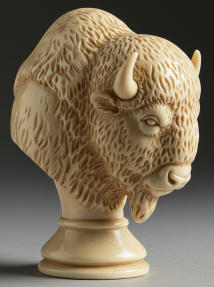Piececlopedia: Bison
Historical notes

Several pieces used in fairy chess problems are leapers or jumpers: pieces that in some way generalize the movement of a knight, but move different numbers of squares in the directions. Many of these pieces have animal names: Camel, Gnus, Antelope, etc. The Bison is also a piece of this family. It appears (infrequently) in fairy chess problems; Jelliss (see reference below) gives a mate in two by P. Monreal and F. Calvet from the Problemist, 1974 as an example.
Movement
The bison can either move one squares in one orthogonal direction and then three in the other orthogonal direction, (like a camel), or two squares in one orthogonal direction and then three in the other orthogonal direction (like a zebra). When moving, the bison jumps, i.e., the move can be completed regardless whether the intervening squares are occupied.
Movement diagram
![]()
![]()
![]()
![]()
![]()
![]()
![]()
![]()
![]()
![]()
![]()
![]()
![]()
![]()
![]()
![]()
![]()
![]()
![]()
![]()
![]()
![]()
![]()
![]()
![]()
![]()
![]()
![]()
![]()
![]()
![]()
![]()
![]()
![]()
![]()
![]()
![]()
![]()
![]()
![]()
![]()
![]()
![]()
![]()
![]()
![]()
![]()
![]()
![]()
![]()
![]()
![]()
![]()
![]()
![]()
![]()
![]()
![]()
![]()
![]()
![]()
![]()
![]()
![]()
The Bison (here depicted with a picture of another animal, the wildebeest) can move to any square with a black circle, regardless whether squares he passes over are occupied or not.
Notes
This piece can generally force checkmate against a bare king, with the help of its friendly king. Try it!
This is an item in the Piececlopedia: an overview of different (fairy) chess pieces.
Reference: G. Jellis, Notes on Generalized Chess, Variant Chess vol. 1, issue 1, p. 8-9, 1990.
Written by Hans Bodlaender.
WWW page created: May 30, 1999.
Last Updated: April 8, 2025.